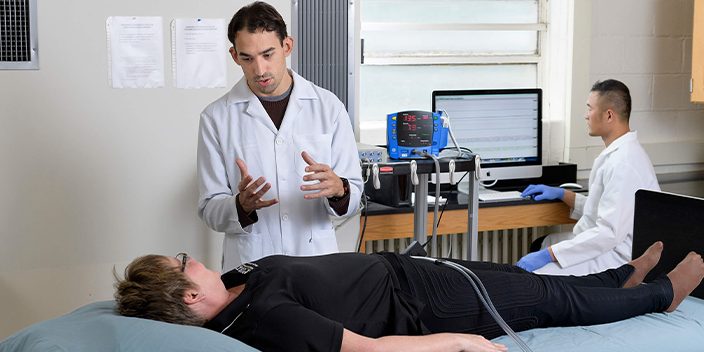Leg heat therapy offers simple remedy for disease that causes pain while walking

WEST LAFAYETTE, Ind. – A new therapy developed by Purdue researchers may help to address a disease that causes pain in leg or hip muscles while walking, eroding mobility for an estimated 236 million people worldwide. The disease often goes untreated, but, in a clinical trial, researchers are hoping that leg heat therapy, delivered at home using hot-water-circulating pants, may improve walking tolerance in people with lower-extremity peripheral artery disease (PAD).
“The most effective therapy to improve walking in people with PAD is a regular routine of repeated bouts of high-intensity exercise, which causes leg pain. These structured exercise programs are often supervised, requiring participants to commute frequently to medical centers. Expectedly, the uptake and adherence to these programs is quite low,” said Bruno Roseguini, project lead and associate professor of health and kinesiology in the College of Health and Human Sciences at Purdue University. “There is a clear need for new therapies that are painless and practical for home-based application.”
Lower-extremity PAD starts with a buildup of plaque in the arteries that carry blood to the legs and feet. Risk factors include smoking, diabetes, high cholesterol, hypertension and older age. The buildup restricts blood flow, depriving downstream muscles of an adequate supply of oxygen and nutrients. When patients walk, climb stairs or exercise, the leg muscles cramp and ache.
With a background in rehabilitation, Roseguini started a research program to explore the therapeutic benefits of repeated leg heating. Initial studies in healthy people and in animal models demonstrated that heat therapy may trigger potentially beneficial adaptations in the leg muscles. Roseguini partnered with Dr. Raghu Motaganahalli, division chief of vascular surgery at Indiana University School of Medicine, to test whether repeated leg heat therapy could be useful for patients with lower-extremity PAD.
“We needed to find a solution to deliver leg heat therapy to elderly patients with limited locomotion,” Roseguini said. “The challenge was getting a therapy that we know works in other formats, like saunas and hot tubs, and transforming that into something that is accessible, practical and targets the legs.”
The team turned to a water-circulating garment originally developed as a thermal management system for astronauts (and dubbed “space pants”) as a controllable and reproducible home-based option. The idea consisted of wearing tube-lined trousers coupled with a water pump. Warm water is circulated through the trousers, heating the calves, thighs and buttocks.
With support from the National Institute on Aging, in 2019 Roseguini and his team conducted a small trial in patients with PAD who routinely experience leg pain while walking. Participants were asked to wear the trousers daily for 90 minutes over eight consecutive weeks. As reported in a paper published in the Journal of Applied Physiology, the results of that study showed improvements in mobility as measured by distance walked during a six-minute walk test.
“We were excited to see that unsupervised leg heating is feasible and safe for these elderly patients,” Roseguini said. “We now needed a larger, definitive trial to test whether this therapy can improve lower-extremity functioning in people with PAD.”
The new study, funded with a grant from the National Institutes of Health and with support from the Indiana Clinical and Translational Sciences Institute, will involve 106 participants. In addition to mobility, the upcoming trial will measure new outcomes, including calf size and strength, that tests whether heat therapy may actually reverse abnormalities in the muscle tissue of patients with PAD.
“If proven successful, this research will pave the way for the development of an effective and inexpensive home-based therapy that could be used to significantly improve mobility and quality of life for literally millions of Americans with PAD,” said Roseguini.
Writer/Media contact: Mary Martialay, mmartial@purdue.edu
Source: Bruno Roseguini